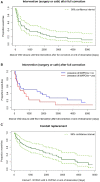Outcome of patients with tetralogy of Fallot with pulmonary atresia
- PMID: 36793501
- PMCID: PMC9922747
- DOI: 10.3389/fped.2022.1077863
Outcome of patients with tetralogy of Fallot with pulmonary atresia
Abstract
Objective: Tetralogy of Fallot patients with pulmonary atresia (TOFPA) have a largely varying source of pulmonary perfusion with often hypoplastic and even absent central pulmonary arteries. A retrospective single center study was undertaken to assess outcome of these patients regarding type of surgical procedures, long-term mortality, achievement of VSD closure and analysis of postoperative interventions.
Methods: 76 consecutive patients with TOFPA operated between 01.01.2003 and 31.12.2019 are included in this single center study. Patients with ductus dependent pulmonary circulation underwent primary single stage full correction including VSD closure and right ventricular to pulmonary conduit implantation (RVPAC) or transanular patch reconstruction. Children with hypoplastic pulmonary arteries and MAPCAs without double supply were predominantly treated by unifocalization and RVPAC implantation. The follow up period ranges between 0 and 16,5 years.
Results: 31 patients (41%) underwent single stage full correction at a median age of 12 days, 15 patients could be treated by a transanular patch. 30 days mortality rate in this group was 6%. In the remaining 45 patients the VSD could not be closed during their first surgery which was performed at a median age of 89 days. A VSD closure was achieved later in 64% of these patients after median 178 days. 30 days mortality rate after the first surgery was 13% in this group. The estimated 10-year-survival rate after the first surgery is 80,5% ± 4,7% showing no significant difference between the groups with and without MAPCAs (p > 0,999). Median intervention-free interval (surgery and transcatheter intervention) after VSD closure was 1,7 ± 0,5 years [95% CI: 0,7-2,8 years].
Conclusions: A VSD closure could be achieved in 79% of the total cohort. In patients without MAPCAs this was possible at a significant earlier age (p < 0,01). Although patients without MAPCAs predominantly underwent single stage full correction at newborn age, the overall mortality rate and the interval until reintervention after VSD closure did not show significant differences between the two groups with and without MAPCAs. The high rate of proven genetic abnormalities (40%) with non-cardiac malformations did also pay its tribute to impaired life expectancy.
Keywords: aorto-pulmonary collaterals; pulmonary atresia; rehabilitation; staged repair; tetralogy of Fallot; unifocalization.
© 2023 Sames-Dolzer, Fahrnberger, Kreuzer, Mair, Gierlinger, Tulzer, Gitter, Prandstetter, Tulzer and Mair.
Conflict of interest statement
The authors declare that the research was conducted in the absence of any commercial or financial relationships that could be construed as a potential conflict of interest.
Figures





References
-
- Bauser-Heaton H, Borquez A, Han B, Ladd M, Asija R, Downey L, et al. Programmatic approach to management of tetralogy of fallot with Major aortopulmonary collateral arteries: a 15-year experience with 458 patients. Circ Cardiovasc Interv. (2017) 10(4):e004952. 10.161/CIRCINTERVENTIONS.116.004952 - DOI - PubMed
-
- Davies B, Mussa S, Davies P, Stickley J, Jones TJ, Barron DJ, et al. Unifocalization of major aortopulmonary collateral arteries in pulmonary atresia with ventricular septal defect is essential to achieve excellent outcomes irrespective of native pulmonary artery morphology. J Thorac Cardiovasc Surg. (2009) 138(6):1269–75.e1. 10.1016/j.jtcvs.2009.08.011 - DOI - PubMed
-
- Liava'a M, Brizard CP, Konstantinov IE, Robertson T, Cheung MM, Weintraub R, et al. Pulmonary atresia, ventricular septal defect, and major aortopulmonary collaterals: neonatal pulmonary artery rehabilitation without unifocalization. Ann Thorac Surg. (2012) 93(1):185–91. 10.1016/j.athoracsur.2011.08.082 - DOI - PubMed
LinkOut - more resources
Full Text Sources

